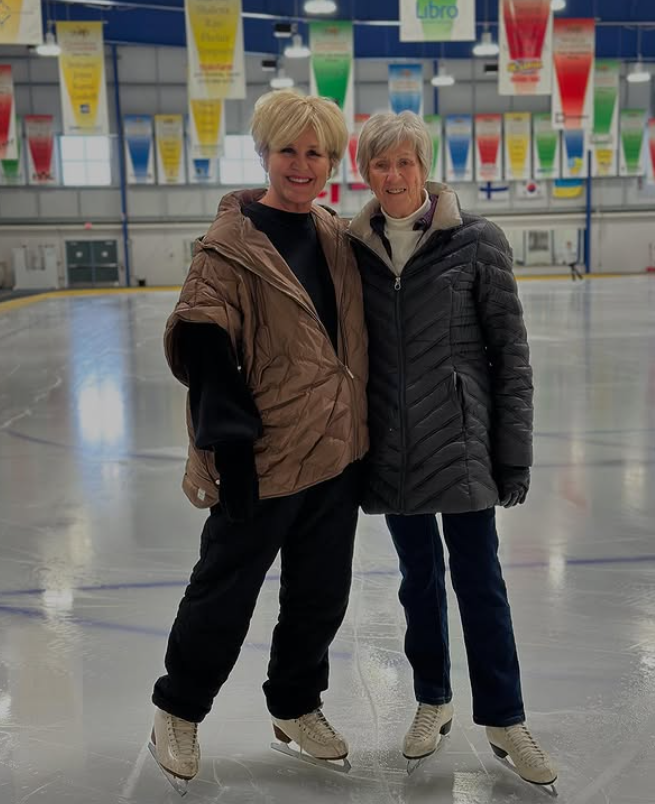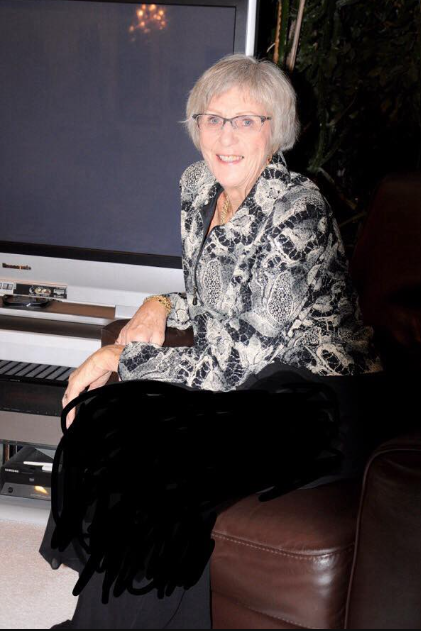welcome-home-blog-by-debbi-wilkes
By: Debbi Wilkes
Synchronized Skating hadn’t even been ‘born’ when Joanne Shaw was growing up in Wallaceburg, a small town in southwestern Ontario between Chatham and Sarnia.

Joanne Shaw (right) and former KWSC Technical Director Pat TeBoekhorst. Photo Credit: Kitchener Waterloo Skating Club on Instagram
In the winter, skating was the thing to do in Wallaceburg either inside the local rink or outside on the Sydenham River adjacent to the cemetery. When the town finally started an actual skating club, Joanne was excited to join and got the okay from her Dad, “As long as I kept up my piano lessons.”
Skating started to take hold and so did Joanne’s dreams. “Neighboring Chatham had all the good skaters, like Sandra Tewksbury,” she remembers. “But with 4 sisters … and my Dad a merchant … he was quick to point out that he couldn’t drive me to Chatham all the time. I’d have to do my best at the local club.”
Joanne took the challenge to heart.
Living in a small town meant figure skaters had to fight for ice time. “At lunchtime the ice was usually free and, despite the fact it wasn’t flooded, I’d go in to practice my figures. One day I did ‘daisies’ … loops … all over the ice surface!”
By the time Joanne was in high school, however, her commitment to skating was beginning to wane.
“Skating gradually became more recreational for me,” Joanne admits. “I’d discovered other things in life like volleyball, basketball … boys … so I wasn’t as dedicated although I still did some of my tests.”
After high school, a career in nursing beckoned, then marriage, then raising a family. “We were living in Burlington at the time,” she recalls. “When my daughter was about 2, I decided to sign us up for the Moms and Tots program at the Burlington skating club … and suddenly I found myself volunteering.”

As Joanne took on more responsibility, her interest in skating was re-kindled, including a desire to judge, thanks to two mentors who recognized Joanne’s potential. They continuously encouraged her over time until she was finally judging at the national level.
By the late 70’s, Precision as it was called then, was starting to get noticed by everyone, including Joanne. “Back then we really had no idea what we were looking at. There were no rules … I called it ‘marching bands on ice’ … but it did look like fun.”
Into the 8o’s, interest in Synchro was growing … and so was Joanne’s involvement. “Teams were expanding what they could do. Elements started to be identified, unique choreography was emphasized, turns became more important, with speed and ice coverage adding to the difficulty.”
The sport was evolving quickly. And with the support of big skating names like Doug Steele, Elizabeth Swan and John McKay, London, Ontario was named to host the first national championships … and that’s when things really took off.
The popularity of the sport came to be applauded for the opportunities it provided skaters outside the usual disciplines of singles, pairs or dance. “It gives people the chance to compete at a high level even if you aren’t a jumper, and that keeps skaters in the sport longer,” Joanne added. “And with such a positive environment, you have companionship out on the ice and friendships that can develop at the same time.”
Internationally, it wasn’t until the mid ‘90’s when our Canadian representative on the ISU, Donald Gilchrist, convinced the ISU that Synchro was a worthwhile investment. As a result, a small group of players began to discuss the possibilities. Finland, Sweden, USA and Canada all worked together to develop the rules and standards … with Joanne’s significant contributions among them.
Her work ultimately led her to the ISU technical committee for Synchro, a role which helped define the parameters of the difficulty seen on the ice today, including how it was to be fairly judged. “Back then, we never imagined seeing Axels, spins or lifts … with all the incredible creativity of movement and formations teams display today. We just wanted Synchro to be recognized as a legitimate sport.”

Joanne Shaw and Les Supremes Junior in 2022. Photo Credit: Guelph Today.
Thanks to Joanne … and other pioneers like her … the first World Synchro Skating Championships were held in Minneapolis in 2000 and have run successfully around the world ever since.
Joanne’s next wish for Synchro? The Olympic Games!
Never Miss an Update
Be the first to know about upcoming Skate Ontario events and special updates—subscribe today!
By submitting this form, you are consenting to receive marketing emails from: . You can revoke your consent to receive emails at any time by using the SafeUnsubscribe® link, found at the bottom of every email. Emails are serviced by Constant Contact


